Layoffs at record low, “quits” near record high with huge number of “hires,” amid massive churn as people go job-hopping.
By Wolf Richter for WOLF STREET.
Large companies in tech (including Microsoft), social media (including Facebook and Twitter), streaming services (including Netflix), used-vehicle tech (including Carvana), and other segments have spread the news that they’re imposing hiring freezes on part or all of their operations, or that they’re actually laying off people, to cut costs as their stocks have come down hard or collapsed. Most of this started in late April and in May. But companies in manufacturing and construction have been lamenting the opposite: labor shortages that keep production down.
Today’s Job Openings and Labor Turnover (JOLTS) for April is beginning to shed the first glimmers of light on these shifting hiring priorities, in a labor market that remains overall super-heated.
In some industries, job openings spiked to new records; in other industries, job openings fell sharply for the first time in this cycle, but remained in the astronomical zone. There were huge numbers of “hires” and near-record “quits” in a sign of massive churn as people quit one job to take a better job somewhere else; accompanied by record low layoffs – that was in April.
Job openings in the astronomical zone. At the end of April, there were a record 12.0 million job openings, not seasonally adjusted, up by 54% from April 2019, according to the JOLTS data released today. On a seasonally adjusted basis, job openings dipped from the record in March to 11.4 million, still up by 57% from April 2019.
These job openings are not based on online job postings, but on what companies and government entities said their hiring needs were:
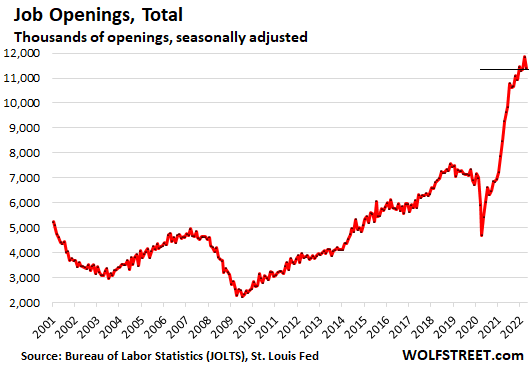
The JOLTS data is routinely cited by the Fed in its rate-hike decisions, specifically the astronomical job openings and the quits – aspects of a “very, very, very strong labor market,” as Powell likes to call it at the FOMC press conferences.
Job openings fell/plunged in big industries, still astronomical.
Professional and business services (includes tech and social media companies and is the largest category by job openings): Job openings fell by 149,000 seasonally adjusted in April from March, the largest drop since April 2020.
But that drop came off the record level of job openings in March, and barely made a dent, with job openings at the end of April at 2.18 million, the second highest ever, and up a stunning 87% from April 2019.
Note that most of the hiring-freeze-and-layoff news from tech and social media came out in May, which should provide for a further and perhaps bigger decline in the next JOLTS release:
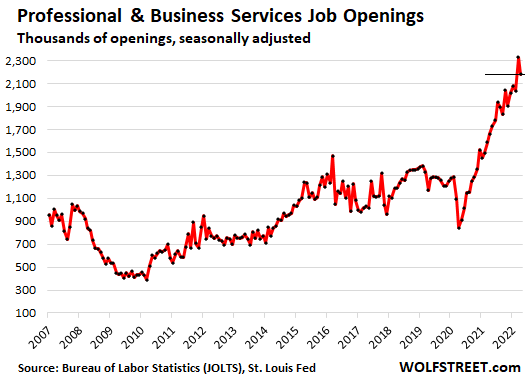
Healthcare and social assistance: Job openings plunged by 266,000 in April from March, seasonally adjusted, the largest drop on record, to 1.80 million openings. But this was still up by 44% from April 2019:
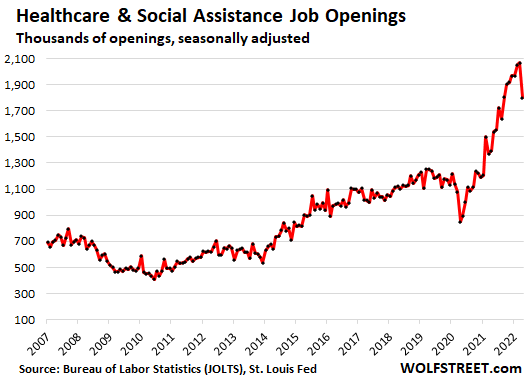
Leisure and hospitality: Job openings have been dropping for months. These companies had hiked pay and were able to fill a large part of the jobs that had vanished during the pandemic, as consumers stormed back to restaurants, hotels, and bars. In April job openings dropped by another 147,000 from March, to 1.51 million, still up by 48% from April 2019:
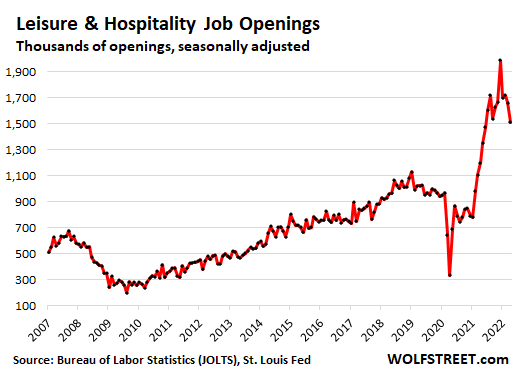
Education and health services: Job openings plunged by 274,000 in April from the record in March, seasonally adjusted, the largest drop ever. But at 2.0 million job openings, the industry is still in the astronomical zone, up by 45% from April 2019:
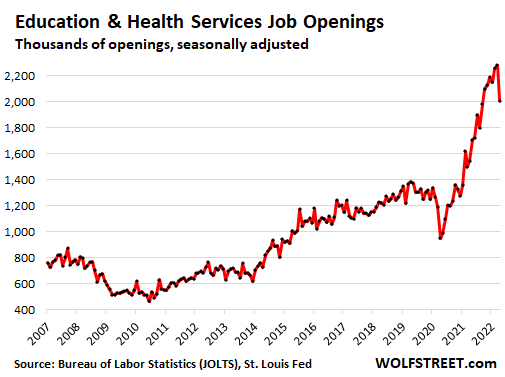
Retail trade: Job openings plunged by 162,000 in April from the record in March, seasonally adjusted, the biggest drop since November 2019. At 1.1 million, job openings are still up by 45% from April 2019:
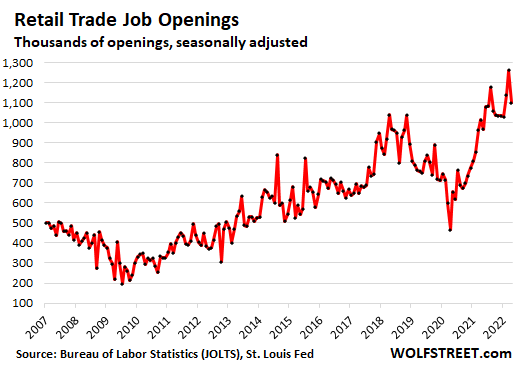
Job openings spiked to record in manufacturing & construction.
Manufacturing: Job openings spiked to a new record of nearly 1 million, seasonally adjusted, up by 115% from April 2019:
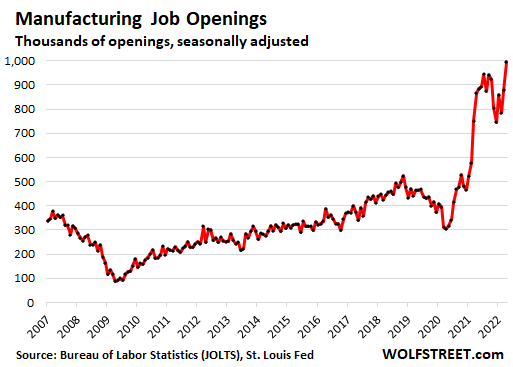
Construction: Job openings rose to a record 449,000, seasonally adjusted, up by 8.5% from the one-month-miracle spike in April 2019, and up by 91% from April 2018:
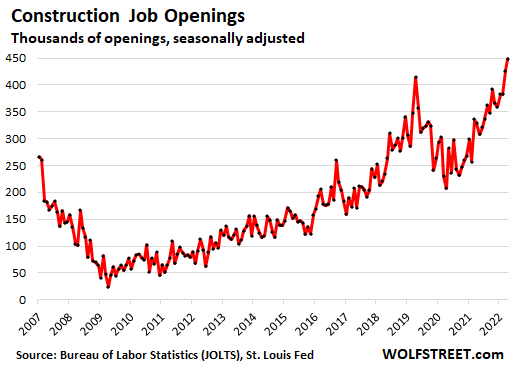
Transportation, warehousing, and utilities: Job openings spiked to 585,000, the third-highest ever, behind September and October last year:
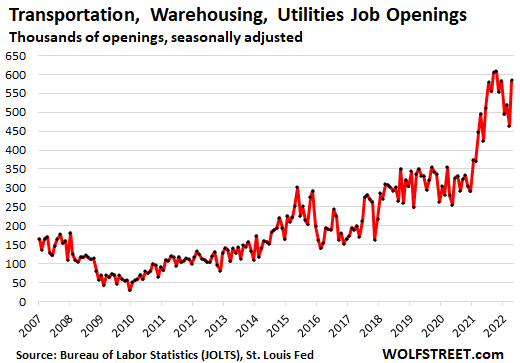
Record low layoffs, near-record high “quits,” aggressive hiring.
Record low layoffs: The number of workers who were laid off or discharged involuntarily in April declined to 1.25 million, seasonally adjusted, the lowest in the data going back to the year 2000:
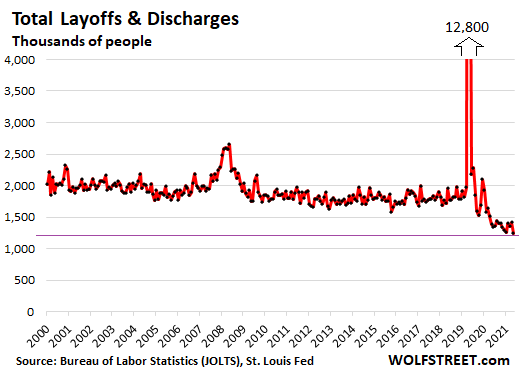
Near-record high “quits”: The number of workers who voluntarily quit jobs in April dipped to 4.18 million, just a tad below the record in November, and up by 26% from April 2019.
These “quits” have been in the astronomical zone since last June, and largely reflect workers who “quit” at one company to fill a job opening at another company, and creating a new job opening where they left.
These quits create a magnificent amount of churn as companies are aggressively trying to hire people who already have jobs, while workers have discovered their power in the labor market. Many are switching to better-paying industries and thereby spread pay increases around the economy, as employers offer higher pay to retain and hire workers.
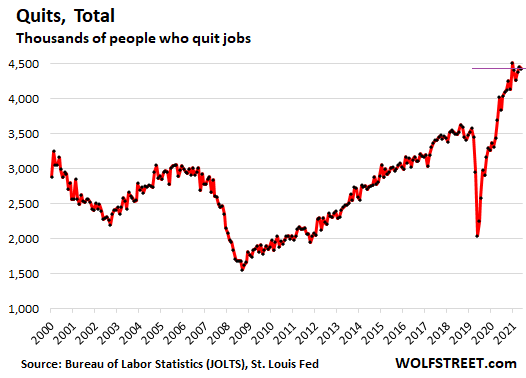
Aggressive hiring: Private sector employers hired 6.2 million workers in April, up by 9% from April 2019, and roughly in the same range since June 2021.
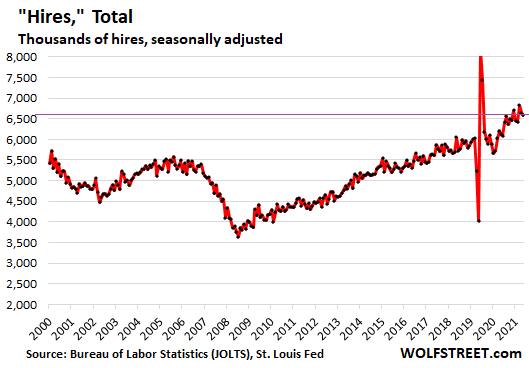
Massive churn. For the past few months, “hires” have been running at about 6.2 million, while “quits” have been running at about 4.1 million, with total job openings roughly stable at near 11.5 million. Which shows that the majority of “hires” filled jobs that had been left behind by the “quits,” and that the “quits” at one company were then showing up as “hires” at another company: the signature of massive churn, as the job opening itself just got shifted from one employer to another.
The number of hires was held down by the difficulties that companies face trying to hire people who already have jobs or who don’t want to go back to work for a variety of reasons.
This super-hot labor market is contributing to the costs for companies, that then try to pass on the costs via higher prices, which is what inflation is. And workers, who’re now able to obtain pay increases or higher-paying jobs somewhere else, have more money to spend for those higher prices, thereby further enabling inflation to thrive. And we’re been off to the races, which we’ve for 15 months.
Enjoy reading WOLF STREET and want to support it? You can donate. I appreciate it immensely. Click on the mug to find out how:
![]()


And we’re off to the races, which we’ve already been for 15 months.*
Sounds like “Learn to Build” will be the next “Learn to Code”?
Just Filled gas at $5/gallon at Costco. Feel frustrated.
The digitization of the economy will continue, and people also need houses.
It’s not a zero sum game.
I wonder how many of these astronomical job openings are duplicates or fake?
I am pestered by offshore (mostly Indian) recruiters on a daily basis. Once I received 11 requests for a job interview by 11 different agencies that turned out to be the same exact contract position.
Also, we are going into a hiring freeze but are still interviewing just in case positions open again.
RTGDFA
Right above the first chart:
“These job openings are not based on online job postings, but on what companies and government entities said their hiring needs were”
It doesn’t matter what recruiters do or say. If the company has “1” job opening, it counts as “1” job opening. This survey goes to companies. It doesn’t go recruiters. Sheesh!!
Sheesh!! reverberates throughout your whole reply! Like, king kong with a megaphone! 🐵📣
Ha, bravo Wolf. Long time supporter, read the GD Fing Article? To go OG, ROTFLMAO. Brilliant.
Read the article, first as always Wolf; however, as one who has worked as recruiter when the my client company had SO much work backed up it needed more labor faster, IMHO there is currently an organized effort by chamber of commerce types to increase the ”apparent” demand for workers to justify the continuing opening of our borders.
That even the majority of folks who have arrived in USA, legally and not, oppose the open borders should be enough to make everyone at least consider that there are NOT, in fact, as many job openings as the companies claim.
And BTW, I am not hearing of shortage of workers in any of the good paying jobs these days, and that is my general observation of the pay offerings I do see.
VintageVNvet,
Whatever. But this data here doesn’t come from any Chamber of Commerce, and isn’t influenced by any Chamber of Commerce. And it doesn’t come from recruiters either. It comes from the companies themselves and their own hiring needs at the time of the survey. Why is this so hard to understand?
It could be a lot of these openings might be fake or never intended to be fill, I am afraid in the next couple of months, more companies will be saying the same thing this POS is telling his employees now, knowing that employment table has fully turned. Hopefully I’ll be wrong, time will tell
“Elon Musk tells Tesla staff: return to office or leave”
“”Everyone at Tesla is required to spend a minimum of 40 hours in the office per week,” Musk wrote in the email sent on Tuesday night.
“If you don’t show up, we will assume you have resigned.”
“The more senior you are, the more visible must be your presence,” Musk wrote. “That is why I lived in the factory so much — so that those on the line could see me working alongside them. If I had not done that, Tesla would long ago have gone bankrupt.””
“…knowing that employment table has fully turned”
Not quite. Job openings are still at near-record highs. They’re huge, just backing down a tad. The hiring freezes we saw in May are likely to push job openings down further, but they will still be far above normal. This is far from being a normal labor market, and for now, labor shortages rule the day. You’ve got to be patient.
But there is already a bifurcation, with people who want to work in an office going to companies that favor that; and with people wanting to work remotely going to companies that offer/require WFH. The Tesla employees can easily get a job somewhere else where they can WFH. And Musk gets to hire some more recruiters to fill the newly empty slots.
That’s good to know, at least the strong employment numbers and still strong openings will continue to supply ammo for the FED to stay on their QT course…another blow to the QT deniers.
On the other hand, I can see it complicate matters for Papa Powell if his target is to lower demand by targeting the job market and reverse wealth effect from housing/stock market. The stock market piece might be falling inline but the wealth effect from housing which I think will be contingent upon people losing their job which then translate to losing their home might not be so easily accomplish, might take a long while..
It’s not a mechanical process. Psychology can change fast tightening credit conditions which is exactly what is happening now with rising rates outside of UST and mortgages. Look at corporates.
Junk bond spreads and rates are already in the process of “blowing out”. Many corporations have extended maturities on their debt, so as long as revenues and earnings hold up, borrowing and interest coverage isn’t a problem. But it doesn’t take much for this to change and fast, as already has happened to “disruptors” and many “tech” companies.
Most corporate balance sheets are either very weak or complete garbage. This is the most obvious weakness in the current cycle peak.
Corporate debt is a low minority of overall debt, but it’s directly tied to employment. Broader extended stock market weakness will also lead to more hiring freezes first followed by job cuts, as C-Suites cut costs as they attempt to beat “Street” EPS estimates.
The interest rates rising has a negative correlation to new and refinanced mortgages.
The openings coming across my desk are either bottom of the pay scale no one could survive on or well paying jobs requiring real skills, physical and mental health and a willingness to produce something of actual value.
exactly
we have LOTS OF JOB OPENINGS
will you work for $12 an hour – or $15 an hour
so sorry that’s all we can afford to pay
What kind of desk do you have?
Yea exactly, my wife has a master degree and was looking for work in a high paying job, but because she has not much experience ( around1 year) she got a job ofer for 15 $/hr
Nothing was wrong with her skills education or personality, but the greedy employers DON’T WANT TO PAY!
If your willing to really work, maybe do some sweating on the job rather than at a gym, and you posses some mechanical aptitude and experience, you can earn some decent dough.
See my comment below.
I believe this is a stealth layoff.
Gets rid of the problem children, no severance and no unemployment compensation.
I bet the algos can predict, to a few percentage points, exactly the reduction and in what departments based on internal emails and social media.
It’s very likely that a significant number of the job openings are for growing the business, assuming the economy keep chugging along. In the next 3-6 months the surveys will come back with much lower numbers as layoffs take by fall. The building industry will be in a tail spin by January as current projects / spending is concluded and new projects are pushed out, just like Wolf’s guest commentator the other day pointed out.
Only a fraction of workers that change jobs get anywhere near a pay increase that keeps up with real inflation. Especially any job not near minimum wage.
“This super-hot labor market is contributing to the costs for companies, that then try to pass on the costs via higher prices, which is what inflation is. And workers, who’re now able to obtain pay increases or higher-paying jobs somewhere else, have more money to spend for those higher prices, thereby further enabling inflation to thrive.”
Some boss kiss me some boss hug me I think they’re okay.
They don’t pay me pretty penny I just walk away.
Because I’m living in a material world
And I am a material guy.
It’s only natural that one might prefer Ciccone to Lewis:
“I’m taking what they’re giving because I’m working for a living.”
Mucho deniro pourquoi travaillez
So, maybe, a correlation between low layoffs and the high churn of quits?
If I am a company that needs to conduct a layoff, just wait for this high natural attrition to do it for me. Or just make one small rule change like you have to show up in the office one day a week to get rid of the problem children.
BONUS. You don’t need to pay severance or unemployment either.
“These “quits” have been in the astronomical zone since last June, and largely reflect workers who “quit” at one company to fill a job opening at another company, and creating a new job opening where they left.”
Reducing the work force “by attrition” (not replacing people who quit or retire) is a classic and good way of reducing the payroll. Much better than mass-layoffs. But these days, most companies don’t have that patience.
I am gonna guess Musk gets at least a 10% voluntary reduction in his “back to the office” rule.
Not a bad first round layoff.
If you didn’t sign any new recent forms at work regarding your employment, and make your case with unemployment, the company will not bother fighting it. They have the insurance, and will not want the threat of a lawsuit.
I’m not looking for a new job, but nobody can afford me anyway.
Rick Scott (R) has a plan to eliminate the labor shortage: repeal the child labor laws and get rid of Social Security to encourage assisted-living residents to go out and make themselves useful.
Now that school will be out soon parents can rent out their third-graders to do piecework. It’ll give them the marginal skills they’ll need in their future careers.
Oh…that’s so funny!
Did you make that up yourself?
You forgot the part about starving children and kicking grandma in the street. But I may have that backwards.
Now go enjoy your egg ration and, if lucky, score some baby formula on the black market.
Senator Skelator is a piece of work. Between him, Little Marco and out Ivy governor who wipes his mouth with his sleeve and calls his minions to punish and engage in cancel culture/free speech by our largest $10/hr employer we have the trifecta. I guess Citizens United means that corporations can exercise free speech as long as they agree with Comerade De. Santis…
You mean President DeSantis.
You mean Darth DeathSentence.
unamused wrote: “Rick Scott (R) has a plan to eliminate the labor shortage: repeal the child labor laws and get rid of Social Security to encourage assisted-living residents to go out and make themselves useful. ”
Most of the people in Assisted Living could do a better job of running the country than the (R) politicians.
At least they wouldn’t have the energy to RiP-The-Face-Off Joe Sixpack so that some Billionaire or Big Corp could have another tax break.
Mitt recently floated the idea of raising the SS/Medicare age to 70.
Every responsible country in the EU is also looking at similar ideas.
73 and still working full time.
Healthy as an ox.
Investing my SS in real estate and PM.
It works for lower-class Asia. Enjoy your imports.
Many assisted living residents could continue getting their ss checks while Medicare continues paying their assisted living fees for 90 days, but then state Medicaid programs kick in. They would have to work remotely “under the table at that point”
A healthy balance sheet has reserves to handle downturns, and carefully teed up liabilities that minimize stress in a hot economy.
For the moment, this seems to me like, broadly, not the worst of all possible worlds. Of course there are always individual exceptions. Inflation impact varies widely, per person.
Aren’t these the kind of “lunch-pail” jobs surging, that the (self-titled) conservatives, nationalists and populists have been touting?
What healthy balance sheets?
Have you looked at balance sheets because I have, for numerous companies. If you think corporate balance sheets are generally healthy, you must have an entirely different definition than I do, as I’d describe most of them as either weak, very weak, or the equivalent of stable rags.
Interest coverage ratios are high now for many because of artificially low rates and fake “growth” which concurrently artificially inflates cash flow. It didn’t take much in 2008 before the credit market came close to “freezing up” and this was before corporate America effectively performed a collective LBO through stock buybacks.
As examples, look at KO, ORCL, UPS, HD, and SO. All are leveraged to the gills, by traditional standards. (ORCL has zero or slightly negative net worth.) None of these are anywhere near at current risk of default, but these are the ones with supposedly “strong” balance sheets which are actually awful.
A F,
Nature dictates that the weak shall perish.
If and when the Rules of Money are put back in place, and that is happening in a slow and incremental manner, then those companies with leveraged and weak balance sheets shall perish too.
This will cause pain. And the pain will not be inflicted upon those in the corporate board room, but it will hit those people that Wolf’s reporting on here in this article.
Life ain’t always fair. But those zombies running on debt, and not on revenue, need to to have their due fate handed to them I firmly believe.
1) Money must have value; it cannot be loaned out for free.
I am watching the 3 Year Treasury, as it is now at 2.84%.
I agree with you.
I was attempting to explain how the job market can unravel a lot faster than many or most seem to think possible, concurrently first eliminating the labor shortage and later turning it into a glut with historically high unemployment.
Unemployment was low prior to the pandemic but the economy was mediocre even while mostly artificial. The only thing then and now creating a fake tight labor market (yet another fake attribute of this economy) is the loosest credit standards ever and borrowing from the future.
The jobs data proves (along with today’s PMI) the economy is roaring ahead full steam. This is very good for the stock market as there has been a lot of ridiculous recession talk out there. I still see houses selling very well in my neighborhood and prices for goods and services are going up everywhere!
US stocks are becoming an inflation hedge as it is very clear the Federal Reserve will never even get close to taming inflation with its tepid 0.25 and 0.5 hikes. They are a joke and in the pocket of Wall Street. I am buying stocks hand over fist!
Today Jamie Dimon came out and tried to scare people with how bad the economy will become. Don’t you believe it. Did he tell anyone in Dec 2021 to sell their stocks? No, he’s buying because the Fed Put is still very much there. This week will be the turning point for the whole market and you can expect to see S&P at 5000 by year end.
Are the investors who believe your hype and hoopla about to get thackamuffled? Just asking.
“Today Jamie Dimon came out and tried to scare people with how bad the economy will become.”
He must be on a Rehabilitation Tour because his personality doesn’t actually have an honesty component.
Did you catch the “Fresh Air” thing about Neutron Jack thing on NPR this afternoon? Talk about the morals of a famished barracuda. Wowsers. Still, attributing the export of US manufacturing to Red China to Welch gives him a bit too much credit, don’t you think?
Manufacturing to Red China?
Not in my house. In a few minutes, the Minnesota Orchestra will have a concert rebroadcast, which concludes with Beethoven’s Fourth Symphony.
Rabbit ears going to an old plasma Panasonic pick up the over-the-air signal. But then the DAC, preamp, subwoofers, main stereo amp and planar magnetic loudspeakers are all made in the USA.
Here’s to the engineers and workers that make it possible to have the best gear — Made in the USA.
Yep. Jack should have stuck with caddying.
I know very little about markets and such… at least compared to most commenters here. And for this reason I love this site because I learn things. Yet, even I know your post here is asinine.
👍
Ben,
Agree that this economy with this kind of job market is not now in a recession scenario. Been saying that for a while.
“This is very good for the stock market…”
Not sure about that. We’ll see. I mean, we saw already. But we know it is very good for rate hikes and QT, and they’re not good for the stock market :-]
Go for it, buy all the stock you can, not only what you can afford to lose but bet the farm on it like Michael Saynor on Bitcoin. This is the only way you can show us your conviction in this strong market.
In fact, I recommend you sink it all in Beyond Meat and Snap, think they will do a quick reversal and up and up we go.
Seasonal Adjustment Programs are adjustable. That is why they call them Seasonal Adjustment Programs. Gee
I am retired with possibly 20 years of life yet. I am financially comfortable and there is literally no amount of money that could persuade me to sell my remaining lifespan. I think there are tens of millions like me.
Your government pension, private pension, social security, 401k will not save you.
In all high inflation times, the retired get wacked.
Literally, dozens of examples from 1920s Germany to 1990s Russia
This will remain to be seen. Not every retirees position is the same.
Correct.
There are the 0.00001% that run their own farms, have gold buried out back, have oil royalties pouring in and have a smattering of IPOs coming online.
Last night 3am I went out in backyard to bury all my crypto. I don’t have a boat.
No one loves inflation, but you are exaggerating the current course of inflation. If hyperinflation occurs, then we are ALL doomed. Save a little of that das Ende der Welt for the popcorn.
History says no.
From the book “When Money Dies” about hyperinflation in post WWI Germany.
Farmers did very well.
Manufacturers that have export markets did extremely well.
And, manual skilled labor did very well. Because they could price their labor by the day or even hour or get paid in barter.
It must kill you to read about someone who isn’t suffering and quaking in their boots about future calamities.
> In all high inflation times, the retired get sacked.
Farmers in my family have done great, Dust Bowl, Great Depression, 70s inflation.
If you love permaculture like I do… it’s just the way life is meant to be lived.
Yep – with everything-bubble asset prices soaring to the moon, tons of people realized they didn’t need to work degrading jobs for peanuts anymore. So total employment stayed below prior highs even though employers are desperate for workers.
But you know, that’s also a warning sign of “inflation dead ahead”. There aren’t enough productive assets and workers to provide the goods and interest/dividend income streams to support so many new retirees.
And an inflationary recession has a way of taking away that “financially comfortable” feeling. Some folks will choose right, stay afloat and stay retired. Others won’t be so fortunate.
The end of the 1981-2020 bond mania means a reversal of rising asset prices, the loosest credit conditions ever, and likely end of “moderate” inflation as a higher proportion of future “printing” goes into goods and services instead of assets.
It also means (noticeably) falling living standards for the majority of the population.
Yes, all those construction and manufacturing workers BANKED major coin from their hedge fund investments and crypto, because we know they were all locked and loaded with uninvested bankrolls before the rally, waiting to BTFD.
Your theory is more likely accurate for the mid level tech workers who had solid savings, in some for or another.
By my count, there’s at least one just like you.
> I am retired with possibly 20 years of life yet. I am financially comfortable and there is literally no amount of money that could persuade me to sell my remaining lifespan. I think there are tens of millions like me.
This is beautiful! I’m in the same boat, probably around about 45 years left.
Capitalism likely dislikes us, and that amuses me.
I too am retired and inflation is killing me and at 65 may have to go back to work.
I have said for decades that retirement is something created in the 20th century for folks to warehouse their savings in stocks and bonds for a Hefty fee.
The 4 percent rule of withdrawals while mutual funds charged 2 percent at the time.
Half someone retirement!
Thanks Fed !
I’m thrilled some are in great shape financially the world is not!
You always have to plan for the unforeseen like living in nursing homes for decades which can burn through a lot of cash.
Really? And what is the average length of stay in a nursing home?
Millions are going to unretire as they become poorer, whether they like it or not.
Part of the recent inflation is presumably due to the spike in fake wealth increasing demand for goods and services which even without the supply chain problems, hasn’t increased sufficiently because “printing”, borrowing, and an asset mania does nothing to increase the productive capacity of the country.
Demand for goods is falling.
Demand for goods at current prices is falling due to income constraints.
Current prices are high because of supply shortages. Income is constrained for the same reason. (No production, no supply, no “real” income.)
Why haven’t those shortages been addressed?
I still can’t totally wrap my head around people “who don’t want to go back to work for a variety of reasons.”
Who in the middle class can realistically afford to just decide to not work while costs of everything are skyrocketing? It was only a few years ago that we were hearing nearly half of America couldn’t even afford a $400 emergency.
I would think the overwhelming majority of middle class folks would have easily burned through their stimulus money by now. Credit card balances are still below their peak and surprisingly low in real terms, but they have been growing at a good clip based on an earlier Woflstreet article. Maybe that’s a component, but definitely not enough to explain the hold-outs. The only thing I see that could explain this is that people are taking cash out of their houses. Some by selling, but the vast majority by pulling equity out… “Cash-out Refi” has to be the most misleading financial term in existence. There’s no such thing as “cash-out” unless the house is sold. Otherwise it’s just borrowing against a theoretical number based on what a buyer *might* be willing to pay at the moment (equity).
As we’ve seen before, equity can and does evaporate overnight. I’m convinced that the cash-out refi crowd is going to find themselves in the same world of hurt that they experienced in the last financial crisis. And by “same,” I mean I actually know people who were burned by cash-out refis in bubble #1, and then were dense enough to go and do it again! People have stunningly short memories. My gut tells me that these folks will be clamoring to get back into the work force just as job openings start falling off a cliff with perfect timing for maximum pain as always.
The job holdouts are at home, busily shorting tech spacs and blockchains and poring over Imploded Stock lists for promising pigeons. And remember, people who sell pot don’t count their profits. They weigh them on the larger Mettler scales.
Just a couple weeks ago Bloomberg, Business Insider, and others were reporting that retail day traders have lost all of their pandemic gains per Morgan Stanley. I don’t know how true that is, but given how many previously hot stocks are down 70%, 80%, or 90%+, I’d say it’s a totally believable claim. I know that all of my co-workers who were bragging about their tech stock and crypto gains have been silent this year. Every last one of them. Several are probably in the red by now, but too shy to admit it. Stay-at-home day traders are not the more sophisticated and larger players making a killing on shorts right now. That would be consistent with study after study showning that the average retail stock picker either loses money or embarrassingly underperforms indexes over time. I’m not buying the argument that day traders are the reason regular folks can avoid work.
“Stay-at-home day traders are not the more sophisticated”
Only those who are not devoted subscribers to Wolfstreet.com.
Ohhowimiss nekked shorts, Arbusto Energy, and Daimler-Chrysler.
Unamused,
Ok, ya got me. Good comeback, and I mean that sincerely ;-)
Some of the hold outs are at home raising their children. Child care is extremely expensive and in many cases it no longer makes sense for both parents to work.
> Some of the hold outs are at home raising their children.
VERY true! Some of us are working hard at things like permaculture. Permaculture has gone mainstream among younger mothers and for good reason.
We are all working, some work is to enrich the top 1% or top 5%, the most valuable work is to enrich ourselves.
There are so many government programs out there. State, local, and federal. Along with community, church, etc. This is part of it also.
And how much per month do all those recipients actually get ?
Do some research on government assistance, unless you have already.
Not much.
Many them are late 50s early 60s and simply elected to retire a year or two early when their nest egg doubled from the low of March 2020 to high in late 2021. I know I certainly thought about it.
“I would think the overwhelming majority of middle class folks would have easily burned through their stimulus money by now. “
Consumer spending is 70% of the American economy buy many fail to ask the essential question of which consumers? My guess is that the top 15% of earners are spending 80% of that 70% figure. They are doing just fine. I know so many people who have made hundreds of thousands profit on their homes and just retired. Even with the minor pullback in the markets, I, like them are sitting on massive stock market gains.
Those people you call middle class are actually very poor. They are not the engine driving the US economy anymore. You can expect inflation (particularly housing) to accelerate from here. Those who leave the stock market with their gains go to the housing market. I expect my home to triple in value in the next ten years. There is too much money in the world and it must go somewhere. We know it’s not going into bonds!
Wow! I hope you’re betting on it.
Why don’t you buy houses “hand over fist”?
If you really want to make money you should mass produce your kool aid and sell it.
Haha, like that comedian that trolled Wayne LaPierre I think you are just trolling us “doomsayers” I guess I am old enough but not too old to miss this type of trolling..well played
People cannot spend gains in mass without selling first and there aren’t enough buyers with cash to buy them out. (There is no “cash on the sidelines” either. That’s a myth. It’s actually mostly debt and besides, for every seller, there must be a buyer. It’s only “cash” changing ownership.)
Collectively, this leaves incurring more debt to increase spending due to gains from the asset mania.
The S&P 500 is up about 25% (yes, that’s all. 3400 to about 4200) from the 2/19/2020 pre-pandemic peak, respectable but hardly spectacular. Add in the pathetic dividend yield and it’s slightly more. So, no widespread windfall there.
This primarily leaves home price appreciation which can only be accessed by selling (not evident based upon low inventory) or cash outs.
> My guess is that the top 15% of earners are spending 80% of that 70% figure.
About a decade ago I came to the stats that the top 20% did 70% of the consumption, heavily geared towards services.
Given income/wealth distribution becoming worse, that 70% should have increased by now.
Given that the real brake on the economy is now on full stop and getting pressed harder just about every day……
Things are going to get interesting.
Jay will only get serious if the cabal believes oil can’t handle a runaway economy goosed by all the government spending about to be unleashed……extra goosed by a decline in the US dollar when the ECB and Bank of Japan start down their road of QT. ECB just released the highest inflation data in just about 80 years.
Could be that as soon as a real slowdown does develop the main brake (oil prices) may be released somewhat……just depends on their real objectives.
The cabal that runs the US has no interest in high interest rates. They prefer to continue to drain the middle class…….and……enhance their own wealth by goosing oil to the moon. The US is becoming a different country right before our very eyes. Well…..not really…..but for the first time they are not even trying to hide their power and existence. In the 70’s they let rates jump so us little guys could keep some of our stuff.
All we can hope is that (as they have done for a long time) they are willing to allow us some crumbs of the pie. For my life ar least…..Bless them…..they have done a great job.
Just for the record……us is everybody with a net worth less than 10 billion or so. LOL.
(banging on calculator)…
Yep. I’m one of us.
The large healthcare org I work for is looking to squeeze middle management. They put freezes on most jobs that are not entry level. The large insurance organization down the street received the same news. A local chemical organization is offering demotions for P4/M2 and above positions. Automation allowed for many an early severance pay and early retirement for all three in the admin assistant roles. All still have giant job openings in warehouses. The problem between those jobs and those being squeezed out is a difference in pay. They are hiring entry level – bodies in the office for $20 an hour. The others that are being squeezed earn between $60-100 an hour respectively. Also, a lot of bonuses are being saved by reducing the cost of middle management. Yep. It is a true wacky way these numbers can play with facts that organizations are bracing for an adjustment of some sort. Most are quoting Powell and doing their part for inflation.
Most large corporations have way too much “middle management”. Layers upon layers that just roll up Gantt charts from the layers below. Then, the division managers present the top level charts in the boardroom on the upper floor.
This encourages shoddy work that eventually has to be reworked, but hey, each iteration equates to better Gantt charts along the way.
Leaner times can expose this insanity to some degree.
How come she can possibly know, printing too much money can cause inflation? She is not a PhD from some ivy league or something. She cant even run a gas station…
Why aren’t people working (or why are there so many job openings)? Among other reasons: pay is too low, hours are irregular, cost of living is too high.
Jobs are advertised at what seem to be a reasonable hourly rate but with no indication as to the number of hours to be worked. Many jobs are “on-call” with zero hours guaranteed. And no regular schedule.
Taxes are high. Living expenses in most areas (especially for renters) is up by leaps and bounds in the last few years (there’s a guy named Wolf something or other who has written about this – you can google him). Public transport is non-existent in most areas so an employee needs to have a car. Employees can’t afford to live where they are needed.
Example: Average rent for a 1br apt in FRESNO (!) is over $1500/month. That’s $18,000/yr after taxes. And the average hourly wage in Fresno is $18.22; a bit more than $36,000/yr before taxes. So your modest 1br in Fresno with utilities and insurance is over 56% of your GROSS income. Even if you share the 1br, the housing alone is nearly a 30% of your GROSS.
So employers aren’t “desperate” – they’re desperate for cheap labor. There’s a Motel 6 near where I live that’s had a banner up for housekeepers @ $17/hr. For the last year. Of course, you can’t live within 40 miles of here on $17/hr. Their business model is based on cheap labor. And that model is now broken.
“Why aren’t people working (or why are there so many job openings)? Among other reasons: pay is too low, hours are irregular, cost of living is too high.”
Ultimately, people only don’t work if they have the financial means to avoid it, regardless of the underlying reason. The three reasons you provided or any others like it have nothing to do with it.
Either someone can avoid work because they can support themself or someone else is doing it for them.
There must be a lot of the latter going on now because the asset mania and fake “growth” have deluded much of the population into believing the country is becoming wealthier when it’s actually increasingly “blind, wretched, poor, and naked”.
You really need to credit the King James Bible for that last line.
Revelations as well. That truly informs.
Thanks for the context. Now your posts make sense.
Just another thumper.
I think multigenerational housing will soon be making a come back.
A new subdivision near us includes a house with 6 bedrooms (2 are master suites), 3800 sqf and sold for 1.2M. They’re designing them for multi gen now.
This is exactly why people won’t work ,went to WAl Mart had a guy approach me about raising minimum wages. Wouldn’t sign form ,told him there paying 16$ a hour . In Omaha minimum wage is 9$ I don’t know anyone paying that.This country is in serious trouble the peons have been squeezed enough they don’t care anymore.Make ceos only earn 7 times there lowest paid employee everything fixed overnight .
When fantasy collides with reality, those who don’t work will starve.
There is a corporate governance problem in the US but applying some arbitrary multiple won’t work. Ben & Jerry’s tried that around 1990. Founders tried to hire a CEO offering $60K which was 5X at the time.
No one meeting their qualifications would take the job.
There has been such extensive social and economic decay in the country, there is no actual solution that first doesn’t require a crash landing in American living standards.
That’s what I consistently read, everywhere. Looking for some supposed “deus ex machina” to magically enable the population to live beyond its means, forever.
Imagine some of those noodle-armed WFH pajama boys having to do a day’s work out in the oil patch or something. I think we’re going to return to the days of “real work,” not pretend crap on a keyboard while day-trading crypto.
Hammering is gonna make a comeback, eh?
Wolf,
Unrelated to the topic at hand but worth mentioning: the YEN / DOLLAR exchange rate closed at over 130 Yen to the Dollar today. It’s closed a few times around 130 in the last month.
But before April / May 2022, the last time it was in the 130 range was…….September/October 1998.
Nearly 24 years ago. Unbelievable! A 130 Yen and (coming soon) 8% mortgage rates! Back to the Future!
It’s similar in the UK, (no matter what the doomsayers come out with) For example, a good number of farmers are saying they are cutting production simple because of a shortage of workers. If you walk down the main streets with shops, you find nearly every shop with a job advert and that is before we get to the “proper” paid jobs.
Europe is not the same, Germany has many jobs available, but most the southern European countries don’t.
Presently, the Office of the Treasurer of the United States is vacant.
Interesting, in that the current United States Secretary of the Treasury is the first woman to hold the position.
But the last 16 people who were the United States Treasurer have been women.
And since August 2012, the requirement for Senate approval is no longer needed. Simply an appointment by the President is all that takes. 14 January 2020 was the last day there was a Treasurer.
Has it mattered? Should that job exist?
‘ Employees can’t afford to live where they are needed.’
This is especially true in geographically isolated tourist spots. All the mtn/beach shacks are now AirBnB, VRBO, etc and no place at all for workers to support the tourist industry. Push is coming to shove.
Thanks to our host for his efforts to explain.
Meanwhile the administration is “fighting” inflation by delaying student loan payments which is inflationary and supresses the labor force participation rate.
And England is fighting inflation by giving everyone energy inflation compensation. The problem can’t also be the cure.